I recently went on Russell Hogg's Subject to Change podcast to talk about the future of the aircraft carrier (and a bunch of other stuff). This is a topic I've discussed before, primarily looking at the difficulty of killing a carrier, but I thought it was worth turning my attention to the positive case for the carrier.
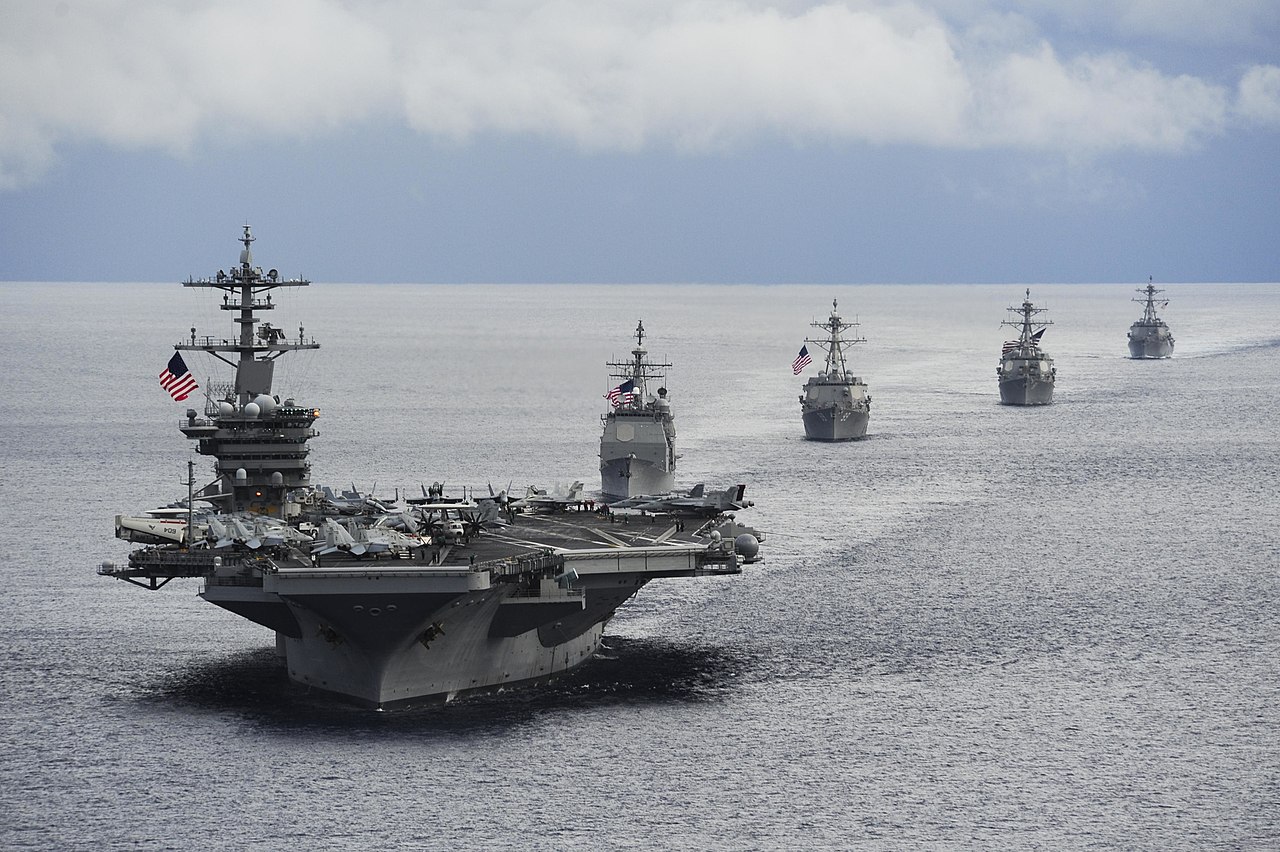
Theodore Roosevelt leads her battle group
Fundamentally, the reason that aircraft carriers exist today, and will continue to exist far into the future is that they are tremendously versatile platforms, useful in a wide variety of situations. This is characteristic of naval forces more generally, which have the ability to contribute to national power throughout a broad spectrum of operations in ways unmatched by land forces and land-based air. An aircraft carrier combines the flexibility of sea power, the impact of air power and serious diplomatic heft all into one convenient package.
Obviously, the heart of a carrier is its air wing, 50 or so F/A-18 Super Hornets, a handful of E-2 Hawkeye AWACS planes, and accompanying helicopters. This is a self-contained package capable of conducting high-end aerial warfare and strike missions on its own, and probably falls somewhere around number 25 on a table of the world's air forces on its own. This isn't immediately obvious. Singapore, number 25 in terms of fighter force, operates 100 aircraft of that type, but virtually all of those on a carrier will be fully operational and their pilots will be worked up. The USN isn't immune from the drains of depot maintenance and training, but those planes are ashore, not on a front-line carrier.1
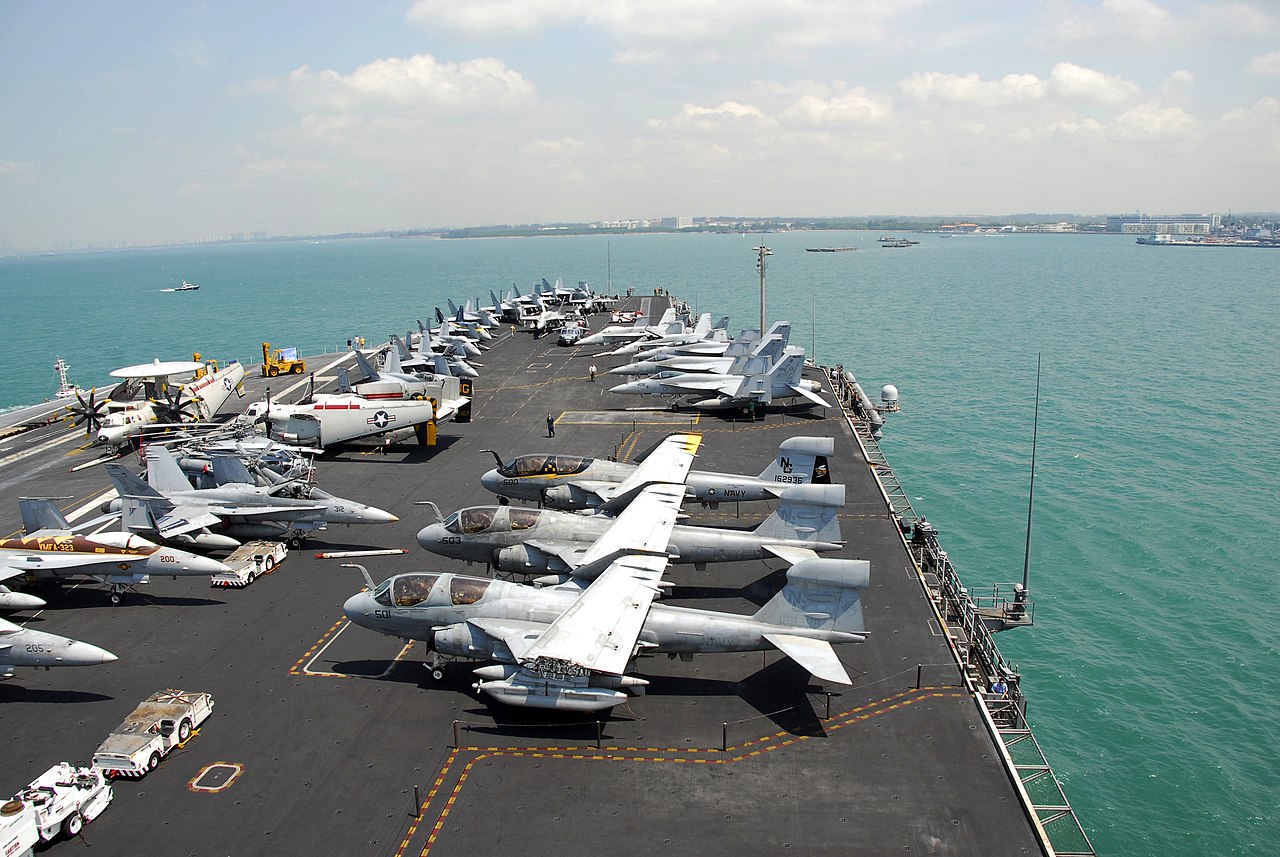
John C. Stennis in Singapore harbor with her air wing on deck
But almost as important as the readiness of the air wing is the manner in which it can be deployed. Unlike land-based air forces, a carrier wing can operate without local bases anywhere there's enough water. This is useful for several reasons. First, it may be difficult to get local bases for diplomatic reasons. Even if local bases are available, they are usually only usable at the discretion of the local government, which can be withdrawn at inconvenient times, such as the 1973 airlift in support of Israel and the 1986 bombing of Libya. A carrier isn't reliant on said bases, giving greater diplomatic flexibility, and probably enhancing the willingness of allies with nearby land bases to go along with the plan, as it's going to happen either way. Second, in a sudden crisis, there may not be a convenient base, and a carrier can get on-scene long before a conventional base can be established and air units deployed from there. This feature alone was a major factor in saving the American carrier force in the early 50s. Before the Korean War broke out, it was facing doom at the hands of the Air Force's bombers, but when Kim Il-sung's troops went south, carriers turned out to be the only means of getting airpower to Korea quickly.
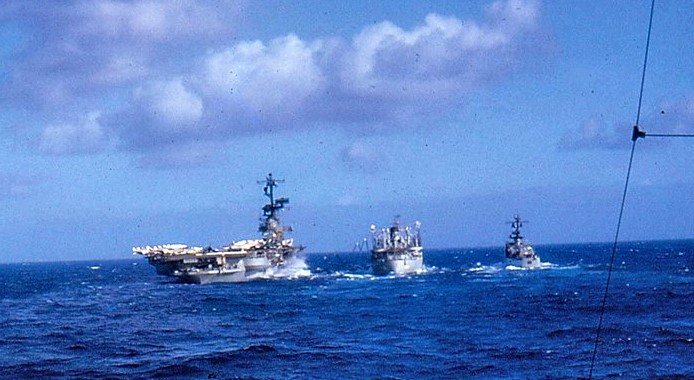
Coral Sea refuels on Yankee Station
Korea set the pattern for carrier employment over the last 70 years. In the smaller wars which have been fought in that period, ranging from Vietnam to the Persian Gulf to the Balkans to Afghanistan, Libya and Syria, they have proven valuable. In fact, starting in the late 60s, carriers have been optimized more for this role than for an all-out hot war. This began with the Nimitz class, where the decision was made to fit big magazines and lots of fuel tankage, which would decrease survivability if the ship was hit, but decrease the frequency of replenishment required to keep it going if it was operating as the carriers were off Vietnam. Subsequent operations have proved the wisdom of this choice, and the new Gerald R Ford class has been even further optimized for lower-intensity operations. Previous carriers were built around "alpha strikes", putting a large number of aircraft over the target at once. The Fords are instead built with a focus on maximizing the number of sorties that can be flown per day, even if this means accepting a lower maximum rate. Some of this is a result of modern precision weapons which allow fewer aircraft to kill more targets, but it's also a response to the way carriers have operated since the Vietnam War, and seem likely to continue to operate in the future.
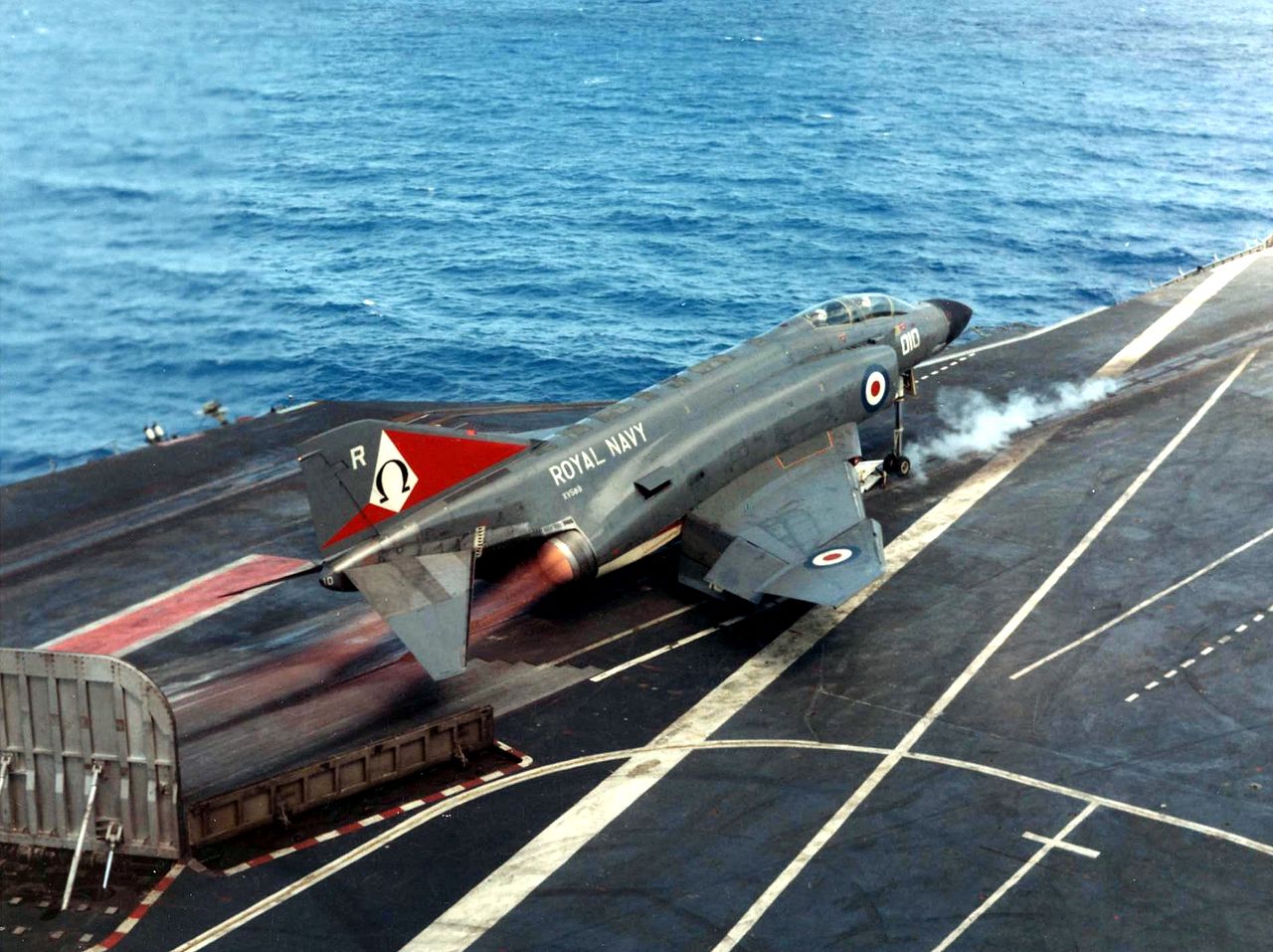
A Phantom flies from Ark Royal, 1972
Nor are the carriers only useful when the shooting breaks out. Naval forces are capable of providing presence in a way that is hard to match. Land forces take much longer to deploy, while air forces can't stay on-station for more than a few hours. Warships offshore are a great way of getting the attention of potentially hostile governments, and have succeeded in preventing conflicts from breaking out in cases ranging from Ark Royal's deployment to the Caribbean in 1972 to deter Guatemala from invading British Honduras (now Belize) to the 1996 Taiwan Strait Crisis when two carrier groups made obvious American commitment to Taiwan.2
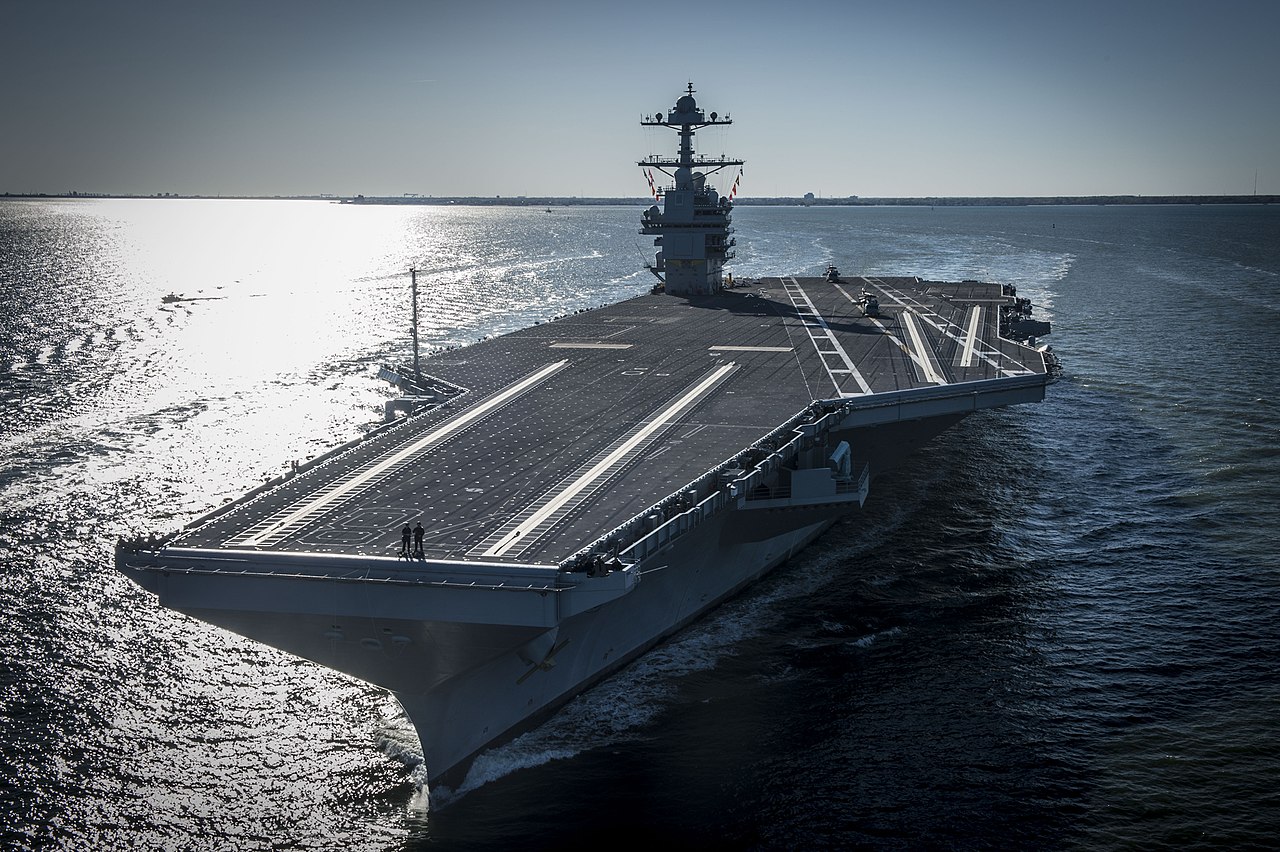
USS Gerald R. Ford
So is the lesson from all of this that the carrier is only useful in situations short of a full-out war? Certainly not. Most warships are useful in a variety of situations, and while you probably wouldn't build carriers if you were only concerned about the hottest of wars (an all-SSBN fleet is what you want in that case) they're certainly not useless in a great-power war. The mobility inherent in naval forces becomes very useful in this case, as they can tie down large enemy forces by threatening action, as was done against the Iraqis in 1991. This was also the American plan during the last decade of the Cold War, and it has probably become even more important since then thanks to the growth of the Chinese ballistic missile force, which menaces any land bases in the region. As carriers can move and the sea is large, killing them is inherently more difficult, and they can use their mobility to force the Chinese to defend in many areas, weakening the forces they can put in the Taiwan Strait.
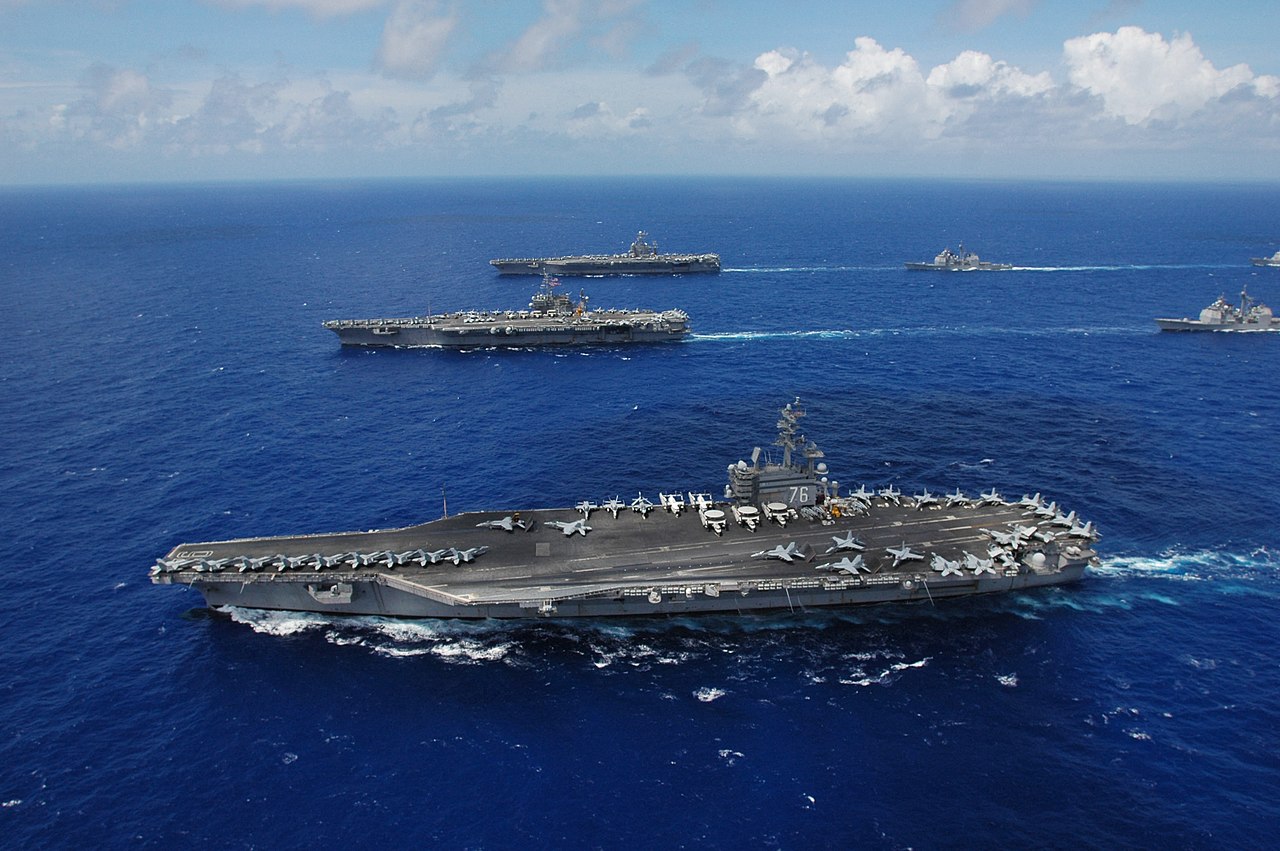
Ronald Reagan, Kitty Hawk and Abraham Lincoln operate together
The bottom line of all this is that the carrier looks to be here to stay. It offers national leaders a powerful and balanced air force anywhere there's water, in conditions ranging from showing the flag to all-out war. Couple that with the ability to respond quickly to crises and the lack of need for local support thanks to underway replenishment and you have something that is well worth the money we spend on it, and will be for the forseeable future.
1 Thanks to Cassander for the figures on air force strength. ⇑
2 Of course, this was also a major catalyst for the growth of the current Chinese Navy, but that's beside the point. ⇑

Comments
This seems like it poses potentially large (or at least not small) risks if things go full hot, especially the smaller alpha strike part. Fighting the last war is still a risk, and not every future conflict is going to be sustained low to moderate intensity operations.
(Survivability I think is fine, once a ship is mission killed, it's mission killed)
I don't think the USN is ignorant of that. Improved sortie generation is one driver behind the change, but the other is that we just don't need alpha strikes of the size we used to, thanks to modern weapons.
I thought alpha strikes were designed for situations where the first 10 planes will get killed by CAP or SAMs, but if you can put 50 on target you'll have 40 doing damage. But nowadays missions like that are flown by Tomahawks or drones. So I'm not surprised that manned alpha strikes aren't considered important anymore.
Not exactly. The main point of an alpha strike is that sometimes you need to drop 100 bombs on the target to kill it, and it's easier to do that all at once than spread out, particularly when you need to add in the support aircraft to escort and do SEAD and EW. Today, we rarely need 100 bombs, and if the target is really hard, we'll use stand-off weapons like Tomahawk or JASSM. So there's just not as much demand.
"...force the Chinese to defend in many areas, weakening the forces they can put in the Taiwan Strait."
How is this supposed to work exactly? I can't imagine getting congressional approval for 'We are making landings at Hainan and Port Arthur' or 'Canton has been left undefended, so we are putting it to the torch to harm the Chinese war effort.'
You plan against an opponent's capabilities, not their intentions.
Also, "We're striking PLAAF airfields around the South China Sea to prevent forces based there from reinforcing the attack on Taiwan" seems like a thing that might reasonably meet with Official Approval during a hot war.
That sort of proves my point. If that is the best flanking attack the US can put together, it is not going to draw off many forces.
The damage done by the raid wouldn't be the important bit. The important bit would be reminding PRC leadership that the USN could show up anywhere, at any time, to hit any military facility within a hundred miles or so of the coast. Thus they have to guard everywhere, all the time.
As David Drake/SM Stirling once (memorably) wrote (it was co-authored, so I can't say for sure which)
Every soldier assigned to rear area defenses that are never engaged are as much out of the fight at the front as though they had been shot in the head.
(More draining, because you have to support them logistically)
Yes, but you can only tie up forces with the threat of invasion if that threat is credible. I don't think it is a big secret both the DoD and Congress wouldn't dare risk an army on the mainland.
You guys were all around for the Neo Balkan Wars; you know how empty air superiority is without boots.
If you can threaten to put 8 divisions ashore in any of 8 different regions, you tie up ~64 enemy divisions.
If you can only threaten to put Zero Divisions ashore, you tie up ZERO enemy divisions.
Note that I wasn't talking about landing troops, I was thinking of air strikes. Every fighter and SAM battery around Hanian or Weihaiwai is one that isn't making life difficult in the Taiwan Strait.
That depends. Air superiority definitely has limits, but within those limits, it's very powerful. Staying outside those limits isn't really possible if you want to fight a modern war, and is rather a pain even if you don't.
Doesn't this go back to the way something like 1.5 million German military in WWII were stationed in German lands doing air defense against the Allied bombing campaign. And they weren't infantry, they were mostly artillery, including all their artillery pieces which were shooting up in the air around Dresden and not at Russian tanks around Moscow. And of course there was the vast % of German aircraft who were shooting down, and being shot down by, Allied bombers instead of strafing enemy troops.
@drpat
What fraction of those bombing missions would be allowed under modern rules of engagement, though. Blowing dams, refineries, sub-stations, bridges, rail-junctions, &c would all be very helpful (and the Chinese would be wise to spend lots of resources to prevent it), but I can't see any of them getting approved; what if someone got hurt being bombed?
"If you can only threaten to put Zero Divisions ashore, you tie up ZERO enemy divisions." PLA divisions in the PRC aren't a problem for Taiwan, unless and until they get air- or sea-lifted to Taiwan. That means the priority is drawing off, tying down, and/or blowing up PLAN and PLAAF assets, which effectively keeps the PLA out of the fight. The emptiness of air superiority "without boots" cuts both ways.
"What fraction of those bombing missions would be allowed under modern rules of engagement, though." You don't need to attack the USAAF's WW2 target set, you just need to attack something the PLAAF can't afford to abandon. PLAAF bases and IADS facilities, for example.
But also - one of the several benefits of small PGMs is that they let you break the things you want broken without having to blow up everything in a quarter mile radius around it. So infrastructure targets could very easily be on the approved target list after all, just as they have been in (IIRC) all US air campaigns since Desert Storm.
@philistine, Honest question: what fraction of the valuables in a modern airforce base is in the form of non-moveable property? Compared to the planes themselves I think hangers and runways are pretty cheep. I guess RADARs and stuff is pretty expensive, but I think you could evacuate much of that in the build-up to war.
RE: infrastructure bombing
I guess in my gut I feel that anything big enough to move the needle on GDP (even on a city level) or mess with supply-lines is going to get people howling bloody murder on humanitarian grounds.
If a peripheral province (for the sake of further argument here, Shangdong) was de-militarized, it feels like the US could have as much air-superiority over it as it wanted and not really be able to do anything to hurt the war effort (within the rules), short of a landing.
tangent: Could the US Army do a traditional siege in today's media environment or would it just not fly? ("Yes, we understand the people of XYZ are going hungry and starting to starve. We will happily feed all of them and reopen the roads once they surrender the city.")
A reasonable amount of that stuff is fixed, and almost all of it has to be there for the base to work. Yes, runways are easy to repair, but things like maintenance equipment and fuel dumps aren't, and without them, it's pretty hard to operate airplanes.
I'm not so sure of this. We've done it in the fairly recent past (Iraq) and if we're in a shooting war with China, we'll probably either do it again or there will be some sort of gentlemen's agreement on what areas are and aren't fair game. Which will protect not only them, but also us.
Depends heavily on how mad the American public is. There's also the option of threatening to send in MREs if they don't surrender. (This is a joke. Modern MREs aren't actually that bad unless they're the only thing you eat.)
IIRC we bombed the hell out of power and telecom nets in the Balkans (including using specialized anti-generator munitions).
And if (as some people speculate) the Chinese are going to engage in destructive cyberwarfare against the US, there's going to be a lot less US domestic opposition to flipping HARMs at their cell towers and bombing the pants off their generators...
The best line I've phrasing on this subject is that carriers will only be obsolete when planes are, because a carrier is just an airfield that is less vulnerable in 95% of circumstances. Yeah, a single warhead can do more damage to it than it can to a land base, but the fact that you have to find the carrier and hit it while it's moving at 40 miles an hour adds far more complication and expense to your targeting effort than adding a few extra missiles to attacking a land base does.
As long as modern fighter sized aircraft are viable front line combatants, putting a bunch of them on a ship to get them closer to the enemy will be a useful exercise.
@philistine
Any conflict with China is (rightly) going to be dominated by the fear of it going nuclear. I would expect massive amounts of messaging about our limited aims with very public declarations of certain things as off limits, and I would not be surprised to see strikes (to say nothing of invasions) of the Chinese mainland to feature prominently on that list. I definitely can't see the US being willing to attack anything that might be seen by the Chinese as disrupting their command and control systems above the theater level.
@ike
Exactly what bean said. A carrier isn't just a runway or even an airbase, it's the whole town around the airbase too, complete with MRO facilities, hangars, ATC, fuel storage, power plant, housing for the people who work there, and even stuff like the grocery store.
If I wanted to mess up an airbase, I wouldn't go after the runways or planes, I'd target the fuel system. Fuel tanks blow up a lot more prettily than runways do and even if they're protected, the trucks, pumps, and other equipment almost certainly aren't, and aren't easily replaceable.
@bean
My understanding of MREs is that the issue is less the taste than the inevitable intestinal distress caused by an all MRE diet...
@Ike
At least from our Air Force's perspective here is what possibly goes into an airfield and how much of it has been made mobile. https://www.wbdg.org/FFC/AF/AFH/afh10222v1.pdf
It used to be known as the Bare Base concept then was switched to BEAR as of course EVERYTHING in the early 2000s had to have the word expeditionary in it. The switch now seems to be back to bare base.
Either way, fuel storage and pumping, electrical generation, and munitions handling are the biggies here. The Civil engineering squadrons can repair a runway and taxiways in hours.
The goal used to be to have things set up for at least refueling and cargo/munitions handling within five days. Not sure if that has even been met. In OEF it took much longer.
That's the beauty of the aircraft carrier. It has all that self-contained and can get quite far in five days...
RE: Nuclear Blackmail
Isn't the Chinese arsenal (still?) set up on the basis of MCD? Meaning, roughly, if they launch everything they get (statistically) one city.
If they launch,
It is hard to think of scenarios where this is a temping trade.
WRT China, there's a very neo-con-y (in the original, not the current Twitter version) view of attacking the PRC that if we hit enough police barracks and party function buildings, the people will rise up and overthrow the CCP. Not sure how much I believe that (and also not sure how much the average Zhou in the street is more moderate than the average CCP apparatchik), but that's a theory out there.
You can obviously extrapolate why attacking the naval flanks of an a threat against Taiwan might be a viable strategy (also it was kind of what the USN wanted to do to the USSR in the 80s).
MAGICK!
I did a search for the word 'EMALS', got 10 results, and everyone of those results brings me HERE... :-D
@Blackshoe
I don't know if I believe all of that. (especially the air-only parts)
Though the thought of provincial governors and regional commanders saying "Gee, the Whites are making gains. What's the best move for my career?" has caused many sleepless nights in Beijing.
Also, you may be right, that a victorious White China is just as big of a problem for the USA as a victorious Red China.
Everyone in the west seems to have forgotten that nationalism was a thing after '45. We tend to see everything through the lens of ideology. Certainly it hasn't helped that pretending to hold a certain ideology is a good way for a small state to get support from a superpower.
I suspect a lot of Chinese people want to see a united China that can stand up to Europe, Japan and the USA. Whether it's united under communism or capitalism or some other -ism is unimportant.
@Lambert
I assume Russia is also on that enemies list.
I'm with Lambert on this. Destroying the government and expecting the populace to spontaneously embrace Freedom, Democracy and McDonald's didn't work too well in Iraq, and every single difference between Iraq and China makes me thing that it was going to work a lot better in Iraq than China. OK, maybe not religion, but you'd have to be an extremely committed neocon to make that argument. I hope this doesn't get any traction.
I could see the Chinese adopting "Freedom, Democracy and McDonald’s" but not pacifism.
'We have the men. We have the money, and, by Jingo, it's our turn.'
We don't really know what the average Chinese person thinks and can't while there's still a dictatorship that people are scared will learn what they said on an anonymous poll and recent emigrants are often scared of family the CCP can threaten and even if wiling to say what they think probably somewhat self-selected for not liking the regime.
ike:
So not all that different from the US.
The least risky regime change option might be fragmentation, but Chinese nationalism may be too strong for that to last.
I'm not just objecting to the idea that we will be greeted as liberators.
What I want to avoid is a situation like in French Indochina and its sucessors where the locals end up with a choice between communism and being a French colony/puppet.
@Lambert
I am confused why you bring up Indo-China. Post-war US policy was to send zero men to help her allies recover their colonies. (from memory this mostly just mattered for the Dutch.)
"The least risky regime change option might be fragmentation, but Chinese nationalism may be too strong for that to last."
A couple thoughts -
*IMHO, Chinese nationalism might well only be solidly found in urban Chinese, not the still-majority of the nation that lives out in the boonies. If you were to decap the CCP leadership or fracture their ability to control things, you might well end up with a rump PRC of Beijing and the coast, and
*The only thing that may be more dangerous than a defeated CCP could be a defeated whatever-comes-next that has to put the pieces back together. They are going to be well and truly pissed that they got their backsides handed to them, and especially by the Yankee imperialists after seventy-something years of being told how special they are. I don't think they'll be under any particular compulsion to play nice or cooperate after that - you could well end up with an attitude like the berserk "We hate EVERYBODY" of the late 50s/early 60s PRC.
Just my .02, YMMV of course. : )
Mike
Mike Kozlowski:
Hard to say and probably not something to bet on either way.
Ethnic minorities are about the people who you could count on not to engage in Chinese nationalism but among the Han Chinese it's likely that most of them have at least some degree of nationalism.
Mike Kozlowski:
Even just giving independence to Tibet and Xinjiang provinces, allowing inner Mongolia to join Mongolia and Taiwan to formally declare independence from China would sure look like a massive defeat and those are about the only changes that I can see actually lasting.
Mike Kozlowski:
Or they'll realize that not cooperating will result in a repeat.
Mike Kozlowski:
You'd probably need a dictatorship of some kind to actually keep that attitude.
@cassander: you say "The best line I’ve phrasing on this subject is that carriers will only be obsolete when planes are, because a carrier is just an airfield that is less vulnerable in 95% of circumstances."
Why couldn't you have said in 1930 that `battleships will only be obsolete when artillery is, because a battleship is just an artillery battery that is less vulnerable in 95% of circumstances.'
Humphrey Appleby:
Aircraft can do most of the jobs of artillery while having superior mobility so it might even be true that artillery is obsolete at least for those who can afford strike aircraft.
I would say that's a fair phrase - but I think it reinforces the point about aircraft carriers - artillery really did get obsoleted as the best way to deliver ordinance under a wide range of circumstances where missiles and planes perform better, in a technological shift that happened in the 1950-1960 period, and was on everyone (except maybe the soviets?) radar after 1945 that the tech was shifting that way. Obviously artillery survives to the current day - but it does so in a role of either backup close air support if you don't have air superiority or cheap/shorter range ordinance delivery missions (though expect to see it getting further phased out in this role in favor of organically embedded suicide drones - it was great not to have to depend on the flyboys for close air support, but if you don't even have to call the jerk at battalion HQ for fires it's even better)
Thus far we don't really have something on the horizon that will replace airplanes as a the best way to deliver lots of ordinance downrange - the nature of the aircraft are changing to some extent (less pilots, more guided weapons), but I don't really see any of the competing tech - directed energy, railguns, hypersonic proplusion, conventional missles, etc. - headed in a direction where it could offer anything like the same bang/buck though they all have their mission set. There are some threats coming from the defensive side as air defense systems get more capable, but then that's part of the promise of the new tech as a way to crack the enemies air defense network so the planes can go in and do the bulk of the work.
There are artillery batteries at sea that aren't battleships, but there are no military fixed-wing airstrips at sea that aren't carriers.
Destroyers are also artilley batteries at sea and they're doing fine (having switched from being floaty gun batteries to floaty missile batteries).
Battleships are a concept with a similar scope to supercarriers, while carriers in general are more analogous to surface combatants.
So we can expect aircraft carriers to be viable for a long time, but it's far from certain that they'll end up resembling today's supercarriers any more than a type 45 resembles HMS Nelson.
I would say that "artillery" isn't a single natural category, and that artillery of the kind that battleships carried is obsolete, made so by guided missiles and nuclear weapons. Just like the battleship. It's hard to find a gun bigger than 155mm in any of the world's arsenals these days. Naval guns tend to top out at 5" for historical reasons, but they're clearly in the same ballpark. Everything bigger is handled by a missile these days, because 6" is about the limit for cheap artillery when you need to delivery lots of small booms. Bigger guns get increasingly expensive and decreasingly effective.
That makes me wonder - are there any roles left for which guns larger than 155mm make any sense, on land or at sea? And if so, by how much and for what? Are there cases where a bigger gun would make sense to use if we had them, but doesn't come up often enough to be worth building?
It seems fairly narrow to me, though maybe if a seagoing 8" gun can be made to fire as rapidly and accurately as a 6"/155mm, and the cost per shot isn't greatly increased, then maybe there's some case for that. That is, if the main case for using a gun at all is delivering lots of small, cheap booms with very little mission planning overhead, then a rapid-fire 8" might do just as well as a rapid-fire 6", with a bit more room to be flexible with the payload if you need to be.
That said, I think the increasing cost and decreasing ROF of anything over 8" makes anything bigger pretty well obsolete, and maybe I'm wrong and 8" is completely eaten by cost too.
I could see an 8" naval gun making some sense, although the problem is that bigger guns get harder to deal with, even at sea. (On land, 6" is the practical limit because above that you get into issues with loading that aren't worth solving.) The Navy looked at building an 8" gun in the mid-70s, but to keep costs down, they omitted the laser-guidance that had been part of the plan, which in turn led to the whole program being cancelled because it didn't make sense without that. Occasionally someone floats reviving it, but if we can't make a guided 6" gun work, why would a guided 8" gun work?
Artillery of the right sort is the most cost-effective way of delivering raw tonnage fire+steel out to a few dozen kilometers, but the "artillery" that is the right sort for this maxes out at 15cm/6" or so. Economies of scale point to bigger guns, except that those have mostly paid off by 15cm and there's always a rate-limiting step somewhere where some guy needs to manhandle the shells and things slow way down if he needs to bring in two of his friends and a chain hoist. Autoloaders haven't changed that.
Sometimes the optimum is less than 15cm/6" because you either need a high instantaneous rate of fire or you are limited in platform size (e.g. it needs to fit on an APC chassis or a corvette, or you need two guys to hump it on an infantry patrol). About the only reason to ever build a gun bigger than 15cm/6" was because you were trying to kill hard targets that 6" shells would bounce off. And that's now a job for missiles.
So, how many medium-caliber guns do you need, and at what point does it start making sense to put them on multiple platforms? The answer is pretty much never going to point to a battleship.
I've never thought that either battleship-caliber guns, or the massive numbers of guns typical of yesteryear's cruisers made much sense.
Lots of platforms with one gun each sounds good, but it seldom works out that you have as many of them as you planned on, when the call for fire comes up, so the idea that's always seemed interesting to me is a moderate number of guns. Probably two twin, so that they can fire on two separate targets and deliver superior ROF to land-based arty, maybe backed up by a secondary battery meant for air/boat defense that can do double-duty in a pinch (76-105mm weapons probably).
Where I wondered, though, is about the caliber of that main battery. Like I said, battleship-sized guns don't seem to make sense - too slow, too hard to work with, too costly per shot, too few cases where you actually need that much boom and a gun still makes sense. But I did note that the 8" guns of the Des Moines class achieved a quoted ROF nearly equal to the ROF quoted for Zumwalt's AGS, and wondered if the "any bigger makes no sense" line sits at 8" instead of 6" for seagoing guns. That said, the fact that 155mm shells are nearly the biggest one man can usefully hump, and 127mm might be the biggest where fixed cases make any sense and the biggest one man can load solo, do seem like relevant limits on further thought. Maybe one can build an autoloader for an 8" that solves this problem, but it would be big and heavy (the ones one the Des Moines were; you could probably make it smaller, lighter, maybe faster today but not by a massive amount).
Let me amend that first line to say "I've never thought that either battleship-caliber guns, or the massive numbers of guns typical of yesteryear's cruisers made much sense" for guided-missile-era designs. They clearly made sense in their own contexts. I'm not one of the "bring back the battleships/heavy cruisers" folks, but I have often wondered, given all the things guns can be handy for, if it might not make sense to have at least a few ships with somewhat heavier gun armament, either in the sense of bigger or more numerous guns.
I guess my question was: battleships evidently got obsoleted decades before artillery, so why couldn't supercarriers get obsoleted decades before aircraft?
I'm not clear on the arrangement for the Des Moines class, except that it took a ship about the size of HMS Dreadnought to carry it. The lightweight 8" mount trialed on the USS Hull, could maintain 12 rounds per minute through the 75 ready rounds in the mount, and then would have been limited by manhandling shells from the magazine. That's the usual issue with autoloaders; high rate of fire in the short term while you go through a ready supply directly coupled to the turret, then much slower afterwards.
If it matters how much weight of fire you can deliver once you've exhausted the ready supply, there's a strong advantage to having shells one man can carry.
@Humphrey
But they weren't. Battleships carried heavy guns to kill hard targets, and were obsoleted when other, more efficient ways to kill those hard targets were created. The big land-based artillery that was intended to kill hard targets was obsoleted at the same time. The artillery that survives, both on land and at sea, is designed for soft targets, and fires a bunch of small shells.
@John
As best I can tell from Friedman's US Naval Weapons, the shells on the Des Moines were manually handled into the hoists from the rotating shell rings. Everything past that was automatic. Because the hoists start at floor level and don't move a lot, this should work pretty well, and with a reasonably big crew, should let them fire off pretty much the entire magazine at a pretty high rate.
@Jade I remember bean arguing for some sort of presence cruiser cheaper than a carrier but that looks impressive alongside in a foreign port. If there really is a good argument for being able to bombard two targets simultaneously with a high rate of fire, then two twin 5" to 8" (and a 3" secondary battery?) sounds like a good fit for that concept. Having said that, quite a few warships dispense with even a single 5", and make do with a 3" (or even a 57mm) so I'm not sure that medium calibre guns are seen as all that useful.
At some point big guns lose to scaling laws right?
An 8" shell will weigh over twice as much as a 6" but its lethal radius (assuming you need a certain overpressure to kill a given target) will only be 33% larger.
And then there's also the option of sending a missile with a tiny little CEP.
You can pack a lot more fragments into the bigger shell, and for a lot of shore bombardment uses, frags matter more than overpressure. Also, the larger shell affords more volume to add gee-whiz features like guidance, rocket assist or odd payloads, though since we've managed to stick LOSBR guidance on a 76mm and SALH on a 127mm, I'm not sure if that matters as much as it once did.
If the guidance is a large fraction of the cost of the shell, there could be an economic argument for using fewer, larger shells, even if it is feasible to fit smaller shells with the same guidance. On the other hand, the cost of the guidance is likely to come down, and if the targets are reasonably dispersed, un/lightly armoured, and the guidance precise enough, you might just need a fixed number of rounds, with the calibre fairly irrelevant.